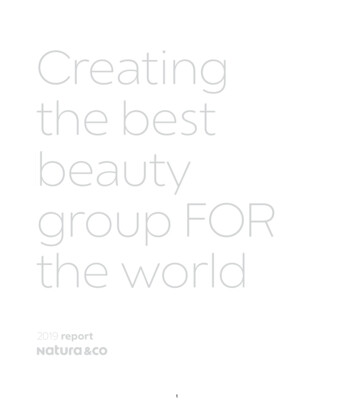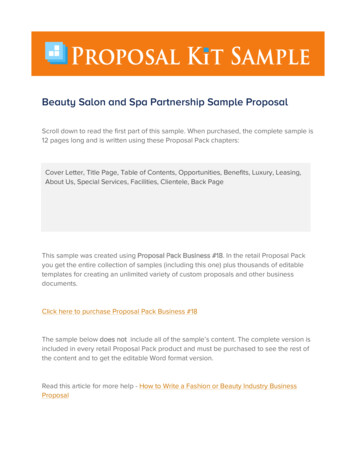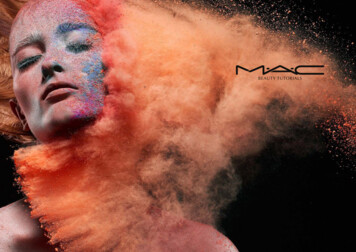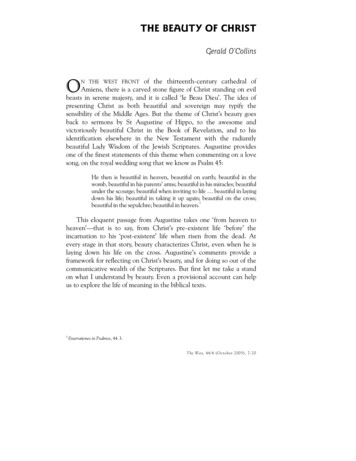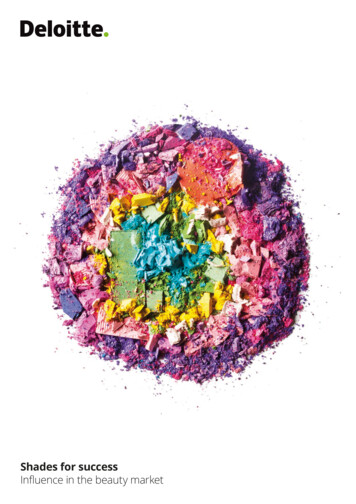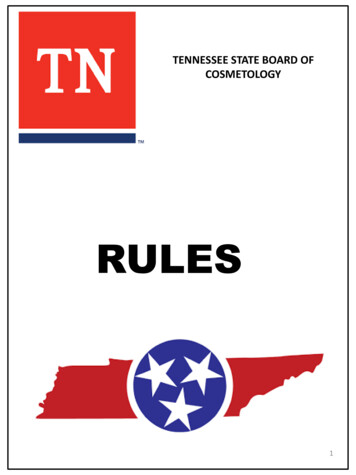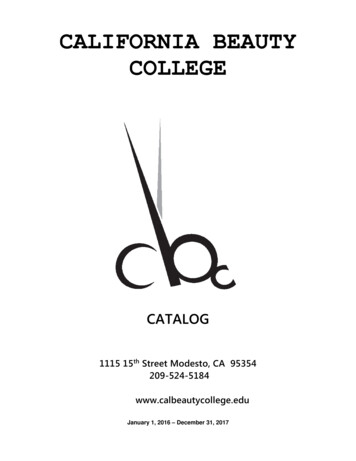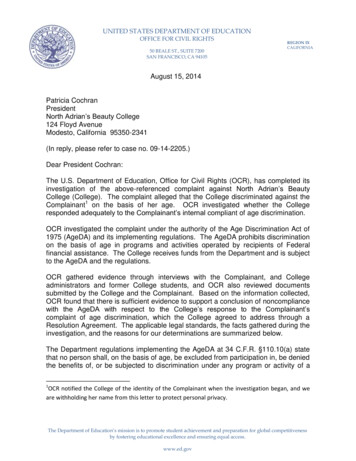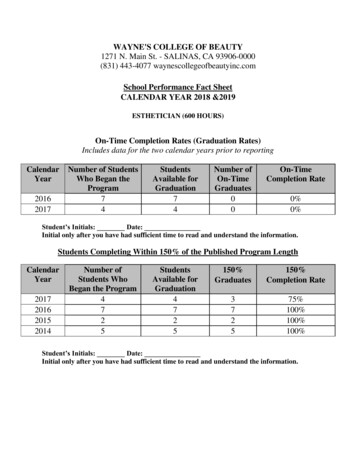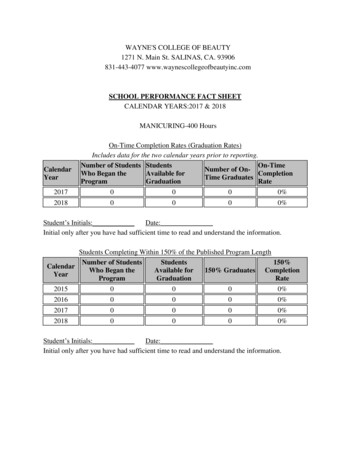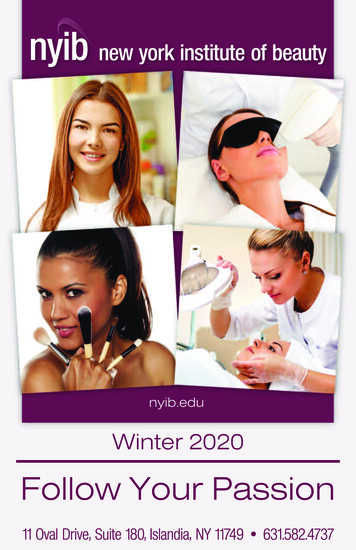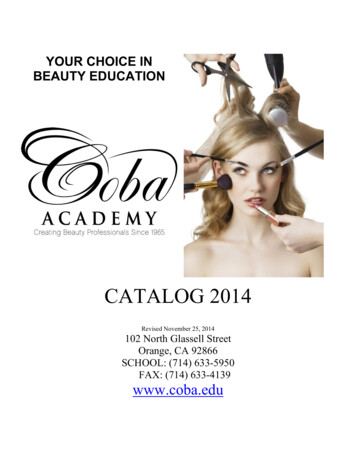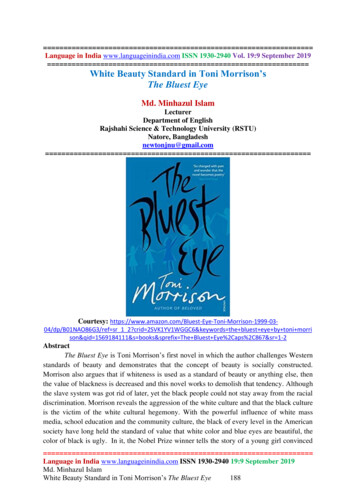
Transcription
Language in India www.languageinindia.com ISSN 1930-2940 Vol. 19:9 September 2019 White Beauty Standard in Toni Morrison’sThe Bluest EyeMd. Minhazul IslamLecturerDepartment of EnglishRajshahi Science & Technology University (RSTU)Natore, Bangladeshnewtonjnu@gmail.com Courtesy: 99-0304/dp/B01NAO86G3/ref sr 1 2?crid 2SVK1YV1WGGC6&keywords the bluest eye by toni morrison&qid 1569184111&s books&sprefix The Bluest Eye%2Caps%2C867&sr 1-2AbstractThe Bluest Eye is Toni Morrison’s first novel in which the author challenges Westernstandards of beauty and demonstrates that the concept of beauty is socially constructed.Morrison also argues that if whiteness is used as a standard of beauty or anything else, thenthe value of blackness is decreased and this novel works to demolish that tendency. Althoughthe slave system was got rid of later, yet the black people could not stay away from the racialdiscrimination. Morrison reveals the aggression of the white culture and that the black cultureis the victim of the white cultural hegemony. With the powerful influence of white massmedia, school education and the community culture, the black of every level in the Americansociety have long held the standard of value that white color and blue eyes are beautiful, thecolor of black is ugly. In it, the Nobel Prize winner tells the story of a young girl convinced Language in India www.languageinindia.com ISSN 1930-2940 19:9 September 2019Md. Minhazul IslamWhite Beauty Standard in Toni Morrison’s The Bluest Eye188
that her blackness makes her ugly and worthless. If only she had blue eyes, she thinks, herlife would be different. The reasons of Pecola and her fellows’ tragedy are mostly lying intwo aspects: the white cultural aggression and the assimilation of white aesthetic standards bythe by the black themselves. Such kind of cultural erosion and aesthetic alienation hasbrought the black into a world of endless misery. Toni Morrison as a black writer is cryingfor the awakening for the whole black nation. She wants her fellows to rectify theirmisunderstanding. All people are created to be equal. The white have their strength andmerits, so do the black because all are making great contribution to the world. Socialconstruction like beauty standard is no more thought to be happened automatically rather thanthey are guided carefully to create social meaning to social significance. Social scientistGiddens theorizes the formation process of social construction. He thinks intentional andauthoritative continuous follow of signification, domination and legitimization can lead to aformation of a new social order. Michel Foucault opines that continuous discursive practiceresults in discursive formation of a social construction. Social construction is not structuredmeaninglessly. American white people are manifestly benefited from ‘white beauty standard’in the past and today from the profit made by the hundreds of years of free labour and nowfrom multi-billion dollar fashion industry. For all races and for all individuals, it is essentialto fully understand how mass culture touches, influences and shapes our values and beliefs only after fully understanding that, people can strive to fight and grow to their fullestpotential.Keywords: Toni Morrison, The Bluest Eye, White Beauty Standards, Racial Oppression,CapitalismIn The Bluest Eye, Morrison challenges Western standards of beauty and demonstratesthat the concept of beauty is socially constructed. Morrison also argues that if whiteness isused as a standard of beauty or anything else, then the value of blackness is decreased andthis novel works to demolish that tendency. In demonstrating pride in being black, this writerdoes not simply portray positive images of blackness. Instead, she focuses on the damage thatthe black women characters suffer through the construction of white beauty standard in aracialised society. As Gurleen Grewal also argues that “merely reversing perceived ‘ugliness’to beautiful blackness “is not enough, for such counter-rhetoric does not touch the heart of thematter: the race-based class structure upheld by dominant norms and stereotypes” (21). In theprocess of structuration, whiteness is first signified, then it dominates over black people andfinally gets legitimized over discursive practices.Toni Morrison depicts the tragic effect of imposing white ideals of beauty in thedeveloping female identity of a young African-American girl during the early 1940s.Morrison portrays the psychological devastation of Pecola Breedlove who searches for loveand acceptance in a world that denies and does not value people of her race (blacks). Thewhites established European standard of beauty: white skin, blond hair, and blue eyes. ThisEurocentric standard of beauty which the black girl lacked was used in judging and Language in India www.languageinindia.com ISSN 1930-2940 19:9 September 2019Md. Minhazul IslamWhite Beauty Standard in Toni Morrison’s The Bluest Eye189
qualifying beauty, thus causing blacks to develop disdain for their own black skin as itcounters the dominant ideals.Set in Toni Morrison’s hometown of Lorain, Ohio, Morrison’s first novel, The BluestEye was published in 1970. The novel tells the story of Pecola Breedlove, a young black girlconvinced of her own ugliness who desires nothing more than to have blue eyes. ThroughPecola Breedlove, Morrison vividly unfolds African Americans’ responses and reactions tothe overpowering standards of beauty in Western culture: rejection, alienation, self-hatred,and inevitable destruction. The nine-year-old narrator in this novel, Claudia, points out in thebeginning of the novel that fear of poverty and homelessness is a more prevalent day-to-dayworry in her community than fear of discrimination, which she declaims “probably because it(discrimination) was abstract. But the concreteness of homelessness and poverty was anothermatter” (Morrison 11). However, the adult Claudia many years later comes to realize that “itis the land of the entire country that was hostile to marigolds that year” (Morrison 164); it isalso the land, not mere poverty and homelessness that dominate the fate of Pecola. Racismaffects people’s lives in subtle yet profound ways by distorting common beauty and standardsof happiness in The Bluest Eye. Morrison tries to show how cultural ideals based on skincolor and physical features function as tools of racial oppression.The novel starts with the description of an ideal white family but in the near-parodicstyle of a school reading primer in order to signify whiteness, where Dick and Jane and theirlovely parents living in a nice and comfortable house with a lovely dog and a cat. The Dickand Jane text functions as “the hegemonizing force of an ideology ([focused by] thesupremacy of ‘the bluest eye’) by which a dominant culture reproduces [its] hierarchicalpower structure[s]” (Grewal 24). As Donald B. Gibson also argues,[t]he Dick and Jane text implies one of the primary and most insidious waysthat the dominant culture exercises its hegemony, through the educationalsystem. It reveals the role of education in both oppressing the victim – andmore to the point – teaching the victim how to oppress her own black self byinternalising the values that dictate standards of beauty (20).Morrison’s allusion to the story of Dick and Jane in a sort of preface to the book,Morrison has written three versions of “Dick and Jane”, which was at that time nationallyrecognized as a children’s primary-reader story.Here is the house. It is green and white. It has a red door. It is very pretty. Here is thefamily. Mother, Father, Dick, and Jane live in the green-and-white house. They arevery happy. Here is the house it is green and white it has a red door it is very prettyhere is the family mother father dick and jane live in the green-and-white house theyare very happy ryprettyhereisthe Language in India www.languageinindia.com ISSN 1930-2940 19:9 September 2019Md. Minhazul IslamWhite Beauty Standard in Toni Morrison’s The Bluest Eye190
housetheyareveryhappy.(Morrison 2).Morrison uses this to “juxtapose the fiction of the white educational process with therealities of life for many black children” (Klotman 123). The first version is clear, straight,rendered in standard English — correct and white. It represents the seemingly ideal, rich,white family, which impinges upon the lives of the black children and their families while atthe same time excluding them. The second version, while it repeats the message exactly, isless clear, yet still comprehensible although written without proper capitals or punctuation.The third, in which the letters completely run together, seems to signify nothing, yet itrepresents the home of Pecola, where her mother and her father curse and fight, her brotherruns away and this black girl herself wishes with all her soul for blue eyes. Just as the Dickand-Jane primer teaches children how to read, it also guides the children’s interpretation ofthe world. Pecola learns to recognize “what is beauty” and “I am ugly and miserable, or atleast my family is” (Morrison 5) through the reading of the story of Dick and Jane, becausehome for her is not the green and white picture-perfect house of white myth. It is worthnoticing that through this public education, the local culture is being oppressed and aseemingly innocent national ideal is being given the highest status.Knowledge of American history is an important factor in understanding The BluestEye. The novel was written during the 60s and 70s, but is set during the 40s. Despite thesetting, her novel reflects the happenings of the late 60s and early 70s in which AfricanAmerican culture was becoming well defined and recognized as a part of the once dominantlywhite American culture. However, racism was and still is quite common in American societyand in fact, racism was taking new forms in 1940s America. In The Bluest Eye, Morrisontook a different approach to the traditional white-versus-black racism. She acknowledged thatmost people are unaware of the racism that exists within a culture and often the racism thatexists within themselves.A fertile tradition of research in sociology and related fields has studied therelationship between status and beauty. These studies have demonstrated that attractivepeople are more successful both socially and economically. This is generally attributed to a“halo effect”: attractiveness produces positive expectations, and this becomes a self-fulfillingprophecy. This paradigm makes a strong case for the social importance of attractiveness.However, it does not account for variations in beauty standards, and it assumes an overlysimple unilinear causal relation between beauty and status. The relation between beauty andstatus may also work the other way: signs of status often come to be regarded as attractive.Such effects are also visible in beauty standards. The process by which status characteristicsare imbued with aesthetic value leads to downward diffusion of standards. This “trickledown” mechanism is central to historical analyses of beauty ideals.The public education has imposed a certain kind of image of a happy life on the children of alocal culture. The novel then switches to the influence of popular culture on the African Language in India www.languageinindia.com ISSN 1930-2940 19:9 September 2019Md. Minhazul IslamWhite Beauty Standard in Toni Morrison’s The Bluest Eye191
American community, and an icon of the good, of the true, and of the beautiful— ShirleyTemple— jumps out.In gender studies and feminist theory, beauty standards are also interpreted as sociallyconstructed rather than given. In this perspective, such standards are a form of control. The“beauty myth” reproduces gender inequalities by propagating unrealistic beauty ideals forwomen (Wolf 95). Gender scholars – like popular discourse – generally point to the media asthe main culprit in the dissemination of beauty standards. This has produced a wealth ofstudies analyzing gender representations in various media outlets.This perspective enables us to re-conceptualise and refine the relation between beautyand social inequality, by pointing at the ways in which inequalities are connected with thehuman body. It predicts that gender is the main factor in the shaping of taste variations, andthat beauty standards are highly morally charged – more so than other aesthetic standards.Race also is an important factor in the relation between beauty, the body, and socialinequality. Racial hierarchies influence beauty standards, both globally and within nations(Hunter 2002; Jones 2008). However, ethnic groups typically develop beauty standardsparticular to their own ethnic group.In The Bluest Eye, Toni Morrison demonstrates the connection between capitalismand the construction of desire in the community when she points out the basic components ofthe society and media like commercials, literary works, kid's toys etc. Capitalism in apostmodern society typically hinges on manufacturing new utilities and desires to functionwithin a racist domain. In this domain, the racist idealization of whiteness has intense sexualand economic associations.If we closely review the adoration of whiteness in the society portrayed in TheBluest Eye, we notice the bond between capitalism and racism. The Bluest Eyereveals just how the patterns of internalized racism utilize the authority ofpostmodern capitalism, its power and methods of representation like kidsgadgets, advertisements etc. to create unconscious desires and fears; andillustrates this interconnection between beauty, racism, and capitalism innumerous incidents narrated in the novel.(Khan)A good example is Claudia's splitting up the Raggedy Ann doll. She actually attemptsto dissect the core of the framework of racism through ripping it apart: “I had only one desire:to dismember it. To see of what it was made, to discover the dearness, to find the beauty, thedesirability that had escaped only me” (Morrison 20). Claudia defies the adoration of whitebeauty that has been put into practice by commercials, a tool of postmodern capitalism, toproduce desire for it. But she fails to understand the politics of socially engineeredidealization, and wrongly locates it inside the material object, that is, the doll. Language in India www.languageinindia.com ISSN 1930-2940 19:9 September 2019Md. Minhazul IslamWhite Beauty Standard in Toni Morrison’s The Bluest Eye192
Beauty standard is always built upon socially fabricated values. Claudia’s perplexityconcerning the representation of beauty refers to that politics. This also is associated withFreud’s idea of the unconscious treatment of words as real things (Freud 147). This is whyClaudia tries to transform symbolic representation of the doll’s beauty into the real andcannot accept it as a form of external representation. When it comes to cinema, according toJean Louis Baudry, we see a similar transformation of the symbolic codes into real properties.Such representations are often incorrectly recognized as perceptions in the postmodernconsumer community (315). In The Bluest Eye, television and movie both play a crucial rolein modifying the framework of internalized racism using such make-believe representationsas genuine impressions. Pauline is governed by the idea of beauty and ideal love when shefinds them as perceptions from movies. Morrison here shows how the notion of ‘beauty’ canbe manipulated by popular media and film to produce racist self-hatred by compellingfemales feel insecure and awful about their figure and color. The ideology of all thecharacters in The Bluest Eye is influenced pretty much by such idealization of whiteness asbeauty in a consumer community. In Pauline’s case, “she was never able, after her educationin the movies, to look at a face and not assign it some category in the scale of absolutebeauty” (Morrison 122). In another context, the female-to-female relationship turns out to befurther complicated when the heterosexual desire is mediated by it. Inside this politics of‘beauty industry’, women are entirely commoditized and considered as mere objects ofdesire. Blackness ends up being a form of economic incapacity. In The Bluest Eye, Morrisonrepeatedly demonstrates, and draws our attention to the prevailing idea that the poverty andblackness of the Breedlove family is related to their economic incapacity, and Pecola is thefundamental embodiment of ugliness related to this economic incapacity.A girl child is described as a female child between infancy and early adulthood.During this period of the development of the girl child, she is under the custody andsupervision of adults who may be her parents or guardians and siblings who are older andmore mature than she is. The girl child is easily influenced by her experiences as shedevelops. She models her behaviour during this development process though observationsand imitations of those she depends on, and her physical, mental and emotional developmentstart and reach their peak within this stage.In attempting to establish the relationship between the society and the girl child, it isimportant to know how she child is received and related with in her contemporary society.What are the struggles, challenges and oppression faced by the girl child? What are thefactors that foist on the girl child such challenges and oppression? From the family circle tothe public sphere, the girl child has suffered much hardship and has been greatlydehumanized. This is due to the fact that she is regarded as inferior to her brother. She isdevalued and as Buchi Emecheta portrays her, she is a second class citizen in a society ruledby male chauvinism. In especially most African societies, the girl child has been consigned toan inferior status for which she constantly wears a daunted image. This inferiority is as a Language in India www.languageinindia.com ISSN 1930-2940 19:9 September 2019Md. Minhazul IslamWhite Beauty Standard in Toni Morrison’s The Bluest Eye193
result of the patriarchal ideology in the society which bestows undue self-importance on themale child. The result of this is that, men do everything to undermine the women in order toarbitrarily institute value and ideologies in the society. The African society and the diasporais a society with a tradition that bestows importance to the male folk, neglecting the femalefolks. This patriarchal ideology has influenced the way the girl characters are projected bymale writers in their literary texts. In most literary works, female characters always wear oneof these images: prostitute, girlfriend, courtesans, and workers. They construct the girlcharacter as a passive and inconsequential object. The male writers communicated a pictureof the girl child as one whose destiny is subject to the whims of her male folk.Klotman comments that “whether one learns acceptability from the formaleducational experience or from cultural symbols, the effect is the same: self-hatred” (124).Very early in the novel, Pecola shows excessive enthusiasm for Shirley Temple, which can beseen from her fascination with Frieda’s blue-and-white Shirley Temple mug and unstoppablemilk-drinking from that mug — three quarts of milk a day. This can be interpreted as a partof her desire to internalize the values of white culture, a symbolic moment that foreshadowsher desire to possess blue eyes. In yearning to be Shirley Temple, Pecola denies her ownidentity, “A little black girl yearns for the blue eyes of a little white girl, and the horror at theheart of her yearning is exceeded only by the evil of fulfillment” (Morrison 34). Pecolaconnects beauty with being loved and believes that if she possesses blue eyes, the cruelty inher life will be replaced by affection and respect. Surely, Pecola suffers most from whitebeauty standards and this hopeless desire leads ultimately to her madness.“As these black people do not possess a place in the domain of white beauty, they derive acomplicated impression of beauty from humiliating people of their own community” (Khan2).In this way Pecola and her family turn out to be the focal point of the wholecommunity's self-hatred. Moreover, by indicating that Pecola’s ugliness help everyone elsefeel beautiful, and her weakness make others feel potent, Morrison tries to reveal how suchidealization predominantly depends on the degradation of an ‘Other’. Throughout The BluestEye, Pecola Breedlove becomes a revalorized entity not just for the whites but also for theblacks. She turns out to be the embodiment of failure both racially and economically whenshe tries to buy a candy from a white American male. He looks at her:Somewhere between retina and object, vision and view, his eyes draw back,hesitate, and hover. At some fixed point in time and space he senses the neednot to waste the effort of a glance. He does not see her, because for him thereis nothing to see (Morrison 48).Thus, her ego lacks any sort of validation in the eye of the ‘Other’ as her existence istotally unrecognized; she is crushed into an instance of self-defiance, a vacuum signifying Language in India www.languageinindia.com ISSN 1930-2940 19:9 September 2019Md. Minhazul IslamWhite Beauty Standard in Toni Morrison’s The Bluest Eye194
nothing, a total absence of acknowledgment as a human being. Pecola knows very well howthis failure of her ego is related to her blackness: “All things in her are in flux andanticipation. But her blackness is static and dread. And it is the blackness that accounts for,that creates, the vacuum edged with distaste in white eyes”. (Morrison 49).Not only she is despised for being black, but her blackness also results in being thefixed object of a perpetual gaze of the white men which forces her presence into the positionof an object of cultural desire detrimentally. Under this constant gaze the ego of the black girlis completely shattered, and she is forced to feel awful for her color, her body, even for herwhole existence. She knows that the whole community has its eye on her even when she isalone. She creates a new, imaginary concept of ‘self’ which she finds in the eyes of the otherpeople, and she begins to believe that image, as in a mirror, to be her true self. When shebecomes pregnant, this image gets associated with a sense of perverse sexism and guilt. Thisguilt is directly related to the blackness of Pecola and her family. In fact, she turns out to be asymbol of ‘guilt’ and ‘ugliness’ in the eye of the community. In a complex way, “thecommunity needs this image of hers to feel better in comparison to her debased position.Pecola’s blackness and pregnancy both serve this purpose” (Khan 3).This further validates the idea of white beauty through self-defiance. This concentration onthe gaze of the white man shows how subjects are maneuvered not only on an imaginary levelbut also on a visual level. Pecola desires to have a pair of blue eyes, because she has adelusional belief that if she obtains blue eyes, she will be beautiful and can reverse therelationship that reduced her to a hollow image in the eyes of the white ‘Other’. Thisobsessive desire ends up in a psychotic attempt to a total denial of her existence: “PleaseGod,” she whispered into the palm of her hand. “Please make me disappear”. She squeezedher eye shut. Little parts of her body faded away” (Morrison 45). This suggests an almostpsychotic withdrawal from the domain of representations through the denial of subjectivityand body.As mentioned by Freud in his book The Unconscious, the subject’s psychologicalworld is shattered and later re-created in an imaginary, unreal fantasy in the first phase ofpsychosis (147). In Pecola’s instance, we notice the very same thing as she first makes aneffort to destroy her identity as a black subject, and then pose an obsessive attempt to obtainblue eyes. This blackness and psychotic desire to obtain blue eyes have a relationship withthe socioeconomic incapacity of Pecola’s family, as their homelessness brings them down asnonhuman objects. According to Lacan, “The-name of- the-father’ links the real order withthe symbolic order. But in psychosis, the subject can no longer deal with ‘the name-of-thefather” (70). Once this relationship is torn apart, the subject is then manipulated by thediscourse of the ‘Other’. In Pecola’s case, her family’s economic condition together with herblackness both eliminates her from the central symbolic order of white consumer culture. Language in India www.languageinindia.com ISSN 1930-2940 19:9 September 2019Md. Minhazul IslamWhite Beauty Standard in Toni Morrison’s The Bluest Eye195
In the framework of racism, the middle class African-Americans accept therepresented associations between blackness and excessive sexuality. According to DavisCharles, one of the primary manifestations of developing ‘obsessive neurosis’ is the desire torepress the irrepressible sexuality through sophistication and differentiation (Slave’sNarrative 1985). Such a form of ‘obsessive neurosis’ is exposed by Toni Morrison in thecharacter of Geraldine. This stems forward from an obsessive effort to stay in line with thepredominant social ‘Other’. Thus, Morrison gives a psychoanalytic layout of the internalizedracism of Geraldine's class. The racist mindset of Geraldine’s class, the acceptedinterconnection between blackness and over sexuality, and a strong urge to stay separatedfrom any sense of sullied blackness is associated with an obsessive fear which turns them into‘obsessive stereotypes’ whose only thought is to renounce blackness by any means. But whenthis obsessive desire falters, it does not destroy the racist mindset; rather further tones up intoa dejection resulting in deeper obsessive delusions. We find it in Geraldine’s obsessiveattempt to turn the skin of her son white:In the winter his mother put Jergens Lotion on his face to keep the skin frombecoming ashen. Even though he was light-skinned, it was possible to ash.The line between color and nigger was not always clear; subtle and telltalesigns threatened to erode it, and the watch had to be constant. (Morrison 87)In the long run, this obsessive fear of any indication of blackness isolates Geraldinefrom her own community. Thus, the psychological hierarchy of the middle class blacks is fedby racist behavior producing from their obsessive fear of discovering themselves in the realmof the terrifying real. This obsessive fear compels them to surrender to the racist discourseestablished by the ‘Other’. Now black people are dominated by the whiteness.In her article “Foucault, Femininity, and the Modernisation of Patriarchal Power”,Sandra Lee Bartky examines the construction of Western femininity by applying MichelFoucault’s theories about the production of subjectivity in modern societies. Foucault arguesthat “discipline produces subjected and practiced bodies, docile bodies” (Bartky 62).However, Bartky recognises that Foucault does not consider gender differences and “is blindto [the] disciplines that produce a modality of embodiment that is peculiarly feminine” (6364). She further argues that analysing disciplinary practices that produce feminine bodiesreveals sexism operating in Western patriarchal society (64). However, in doing so, Bartkydoes not consider racial differences. She argues that –the larger disciplines that construct a ‘feminine’ body out of a female one areby no means race- or class-specific. There is little evidence that women ofcolor or working class women are in general less committed to the incarnationof an ideal femininity than their more privileged sisters. (Bartky 72) Language in India www.languageinindia.com ISSN 1930-2940 19:9 September 2019Md. Minhazul IslamWhite Beauty Standard in Toni Morrison’s The Bluest Eye196
It may be true that beauty is a central focus of many women, and according to NaomiWolf, this is a very powerful myth (49). Yet, since the ideal of beauty is and has been largelydepicted as a woman with light skin and blue eyes, it is even less possible for women ofcolour than for white women to achieve this ideal. As Paul C. Taylor argues, “a whitedominated culture has racialised beauty, in that it has defined beauty per se in terms of whitebeauty, in terms of the physical features that the people we consider white people are morelikely to have” (17). Therefore, in the process of trying to achieve beauty, as Taylor furtherargues, “the experience of a black woman differs from the experiences of Jewish andIrish women” (20). This can clearly be seen in the ways that the black women characters inMorrison’s novel suffer in trying to conform to Western standards of beauty.The Bluest Eye concentrates on the black African-Americans’ desire to leave theirown value system and start adopting Eurocentric values materialism, capitalist success andbeauty and how those all desires remain ‘unrealistic’, ‘destructive’ and ‘un-necessary’(Kohler 40). The black community in the novel is continually devalued by the Euro
developing female identity of a young African-American girl during the early 1940s. Morrison portrays the psychological devastation of Pecola Breedlove who searches for love and acceptance in a world that denies and does not value people of her race (blacks). The whites established European
